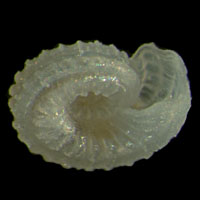|
< Previous family introduction |
|
|||||
 |
Family Orbitestellidae Orbitestellids
|
|||||
|
The Orbitestellidae is a family of minute, umbilicate shells predominately restricted to the southern hemisphere. There are about 30 species currently recognised, mainly in the genera Microdiscula and Orbitestella, four of which are known from NSW. The family was first recognised by Tom Iredale in 1917, who placed it in the superfamily Trochoidea, based on similarity of its shell form to some of the Trochidae. In 1954 Charles Laseron treated some of the species in his review of the Liotiidae of NSW (Laseron, 1954). Working only from shell morphology he grouped together in the Liotiidae minute and small shells, varying in form from discoidal to elongate, elaborately or simply sculptured, umbilicate or non-umbilicate, which have subsequently been determined to span the range of gastropod anatomical structure. Laseron was well aware of the inadequacy of his treatment and said his work should be regarded "as a preliminary for the deeper study of the group". Ponder (1990) provided a sound anatomical basis for the classification by investigating the anatomy, radula and shell of Microdiscula charopa and placed the family among the lower hererobranchs, well removed from the superfamily Trochoidea. Orbitestellids live in the lower littoral and sublittoral zones, under stones, in rubble or on algae. Specimens are usually collected by washing stones and algae, and the exact habitat of the several species is still not known. Family References Laseron, C. 1954. Revision of the Liotiidae of New South Wales. The Australian Zoologist 12: 1–25. Ponder, W.F. 1990. The anatomy and relationships of the Orbitestellidae (Gastropoda: Heterobranchia). Journal of Molluscan Studies 56: 515–532. Coverage All the named species from NSW are detailed here. Identification Notes Orbitestellid shells are recognised by their minute size — less than 1 mm — low or depressed spire and wide umbilicus. Small shells of similar form are found in the Skeneidae and Tornidae, but most are not as small as the orbitestellids.
|